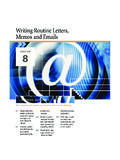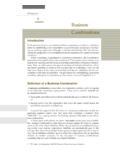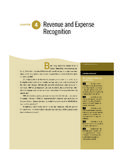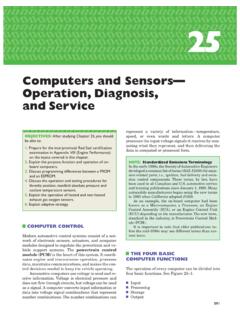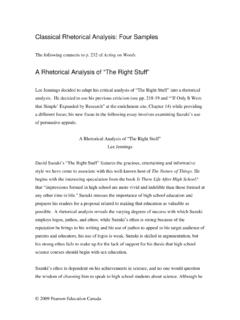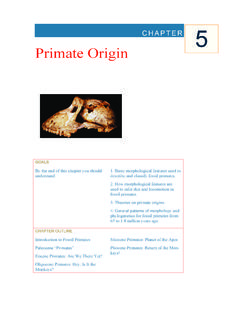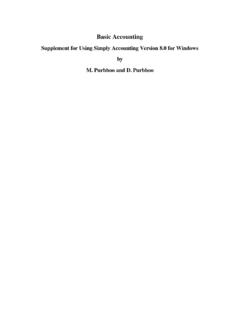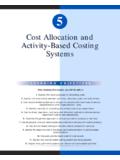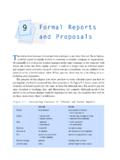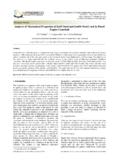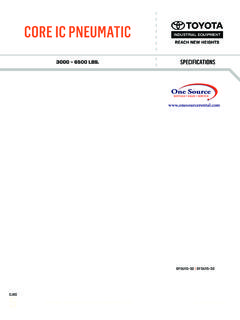Transcription of Camshafts,Valve Trains, Intake and Exhaust Systems
1 1709 The cam is driven by timing gears, chains, or belts lo-cated at the front of the engine. The gear or sprocket onthe camshaft has twice as many teeth, or notches, as theone on the crankshaft. This results in two crankshaft rev-olutions for each revolution of the turns at one-half the crankshaft speed in all four-stroke-cycle FUNCTIONThe camshaft s major function is to operate the valvetrain. Cam shape or contouris the major factor in de-termining the operating characteristics of the lobes on the camshaft open the valves against theforce of the valve springs.
2 The camshaft lobe changesrotary motion (camshaft) to linear motion ( valves ).Cam lobe shape has more control over engine per-formance characteristics than does any other singleengine part. Engines identical in every way exceptcam lobe shape may have completely different oper-ating characteristics and performance. See Figure9 1. The camshaft may also operate the following: Mechanical fuel pump Oil pump DistributorSee Figures 9 2 and 9 LOCATIONP ushrod engines have the cam located in the block. Thecamshaft is supported in the block by camshaft bear-ingsand driven by the crankshaft with a gear orsprocket and chain drive.
3 See Figure 9 4. Many over- camshafts , valve trains , Intake and Exhaust SystemsOBJECTIVES:After studying Chapter 9, you shouldbe able for the interprovincial Red Seal certificationexamination in Appendix I (Engine Repair) on thetopics covered in this how camshafts and valve trains valve train noise and its how a hydraulic lifter the operation of variable-length the differences between air cleaners for wet and dry the relationship of valve timing to intakerunner 9 1 This high-performance camshaft has a lobe thatopens the valve quickly and keeps it open for a long camshaft (OHC)
4 Engines do not use cam bearings;the camshaft runs directly on the aluminum cylinderhead. In order to salvage heads with a worn camshaftbore, the aftermarket suppliers often providecamshafts with larger bearing journals. The head isbored (machined) to match the new, larger cam. An-other repair method is to bore out the head and installbearings that allow the use of the original PROBLEMDIAGNOSISA partially worn lobe on the camshaft is often difficultto diagnose. Sometimes a valve tick tick tick noise isheard if the cam lobe is worn.
5 The ticking noise can beintermittent, which makes it harder to determine thecause. If the engine has an overhead camshaft (OHC),it is usually relatively easy to remove the cam coverand make a visual inspection of all cam lobes and therest of the valve train . In an overhead valve (OHV) en-gine, the camshaft is in the block, where easy visualinspection is not possible. See Figure 9 5 and Tech Tip The Rotating Pushrod Test. Push rod engines with flat tappets often use thecam lobe taper and lifter offset to push the camshaftin toward the block.
6 No cam thrust plate (retainer) isrequired. camshafts designed for roller lifters haveno taper and must use a retainer to keep thecamshaft from walking back and forth in the REMOVAL(PUSHROD ENGINE)If the engine has an overhead valve design, thecamshaft is usually located in the block above theCamshafts, valve trains , Intake and Exhaust Systems171 Figure 9 2In many engines, the camshaft drives thedistributor and the oil pump through a shaft from the endof the 9 3 The fuel pump plunger rides on the 9 4 Cutaway of a Chevrolet V-8 showing the valvetrain TIPThe Rotating Pushrod TestTo quickly and easily test whether or not the camshaft isokay.
7 Observe if the pushrods are rotating when the engineis running. This test will work on any overhead valvepushrod engine that uses a flat-bottom lifter. Due to theslight angle on the cam lobe and lifter offset, the lifter (andpushrod) should rotate whenever the engine is running. Tocheck, simply remove the rocker arm cover and observethe pushrods when the engine is running. If one or morepushrods is notrotating, the camshaft and/or the lifter forthat particular valve is worn and needs to be replaced. crankshaft. The timing chain and gears (if the vehicleis so equipped) should be removed after the timingchain (gear) cover is removed.
8 Loosen the rocker arms(or rocker arm shaft) and remove the pushrods. Re-move or lift up the lifters before carefully removingthe camshaft. See Tech Tip The Tube Trick. CAMSHAFT DRIVESThe crankshaft gear or sprocket that drives thecamshaft is usually made of sintered iron. Whengears are used, the camshaft gear teeth must bemade from a soft material to reduce noise. Usually,the whole gear is made of aluminum or fibre. See Fig-ure 9 6. When a chain and sprocket are used, theNOTE:Be sure to keep the pushrods and rocker armstogether if they are to be 9 Figure 9 5(a) Here is what can happen if a roller lifterbreaks loose from its retainer.
9 The customer complainedof a little noise from the engine. (b) All engines equippedwith roller lifters have some type of retainer for keepingthe lifters from rotating.(a)(b)TECH TIPThe Tube TrickValve lifters are often difficult to remove because theends of the lifters become mushroomed (enlarged)where they have contacted the camshaft. Varnish buildupcan also prevent the lifters from being removed. Try thismethod:Step the lifters upward as far away from thecamshaft as in a thin plastic or cardboard tube withslots in place of the the lifters downward into the tube.
10 Use along magnet to retrieve the lifters from the end ofthe trick will work on almost every engine that hasthe camshaft in the block. If the tube is made from plas-tic, it has to be thin plastic to allow it to flex slightly. Thelength of the lifters is greater than the diameter of thecam bearings. Therefore, the lifter has to be pusheddownward into the tube slightly to allow the lifter roomto fall over into the tube. Figure 9 6 The larger camshaft gear is usually made fromfibre and given a helical cut to help reduce noise.
